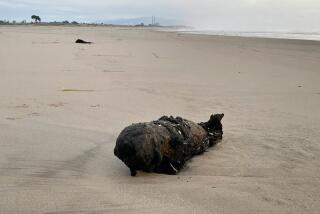Workmen Unearth 1-Ton ‘Hermann’ : Echoes of the Blitz: WWII Bomb Defused in London
- Share via
LONDON — Bomb-disposal experts Tuesday defused a one-ton World War II-era German bomb that was unearthed at a construction site on the banks of the Thames River near Tower Bridge. The operation forced the evacuation of 2,000 residents for more than a day, police said.
The seven-foot-long bomb was discovered Monday by workers using a pile driver on a construction site at Bermondsey, on the south bank of the Thames about 500 yards from Tower Bridge in London’s East End.
The workers who found the device thought at first that they had unearthed a length of iron piping.
Construction foreman Michael Killeen said: “We hit an obstruction, and when the rig (the pile driver) would not go through it, we brought in a digging machine.
“We thought it was a cast-iron pipe. We picked it up and then let it drop. . . . It was only then we realized that it looked like a bomb.”
It was actually a 2,200-pound “Hermann,” one of the largest type of bombs the Germans dropped on Britain during the Blitz. Wartime Londoners gave the bomb its nickname because its rotund shape reminded them of Hermann Goering, the hefty head of the German air force.
Area Sealed Off
Police responded to Killeen’s discovery by sealing off a wide patch of Bermondsey, an area that was heavily damaged during the war. Three schools were closed and train service in the area was canceled.
Police also went through each apartment block in the area and guided most residents to vehicles that took them to temporary shelters in community centers.
But a few resisted.
Police Chief Inspector Roger Pool said, “Some elderly people said Hitler didn’t get them in the war and there was no way he was going to get them now.”
After the evacuation and several meetings to decide tactics, a 10-man bomb-disposal unit led by Capt. Chris Goddard of the Royal Engineers moved in early Tuesday.
The team worked 18 hours to deactivate the device, first removing the bomb’s fuse and then melting the explosives encased in the huge shell.
“We had some problems,” Goddard said, “because the fuse was so corroded. The Germans were very meticulous and always put serial numbers on the fuses, which meant we could easily identify the type of bomb and know just what to do to deactivate it.
“This time the serial numbers were missing because of the corrosion. So we had to discover the type of bomb through a process of elimination.”
Several unexploded bombs dropped during the war are discovered every year in Britain. Most of those found in London have been in the Thames River itself rather than on land.
More to Read
Sign up for Essential California
The most important California stories and recommendations in your inbox every morning.
You may occasionally receive promotional content from the Los Angeles Times.













